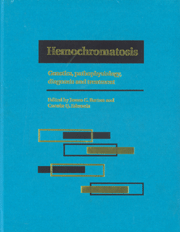Book contents
- Frontmatter
- Contents
- List of contributors
- Foreword
- Part I Introduction to hemochromatosis
- Part II Genetics of hemochromatosis
- Part III Metal absorption and metabolism in hemochromatosis
- Part IV Diagnostic techniques for iron overload
- Part V Complications of iron overload
- Part VI Therapy of hemochromatosis and iron overload
- Part VII Infections and immunity in hemochromatosis
- Part VIII Hemochromatosis heterozygotes
- 39 The iron phenotype of hemochromatosis heterozygotes
- 40 Ascertainment of hemochromatosis heterozygosity
- 41 Disease risk in hereditary hemochromatosis heterozygotes
- Part IX Relationship of hemochromatosis to other disorders
- Part X Animal models of hemochromatosis and iron overload
- Part XI Screening for hemochromatosis
- Part XII Hemochromatosis: societal and ethical issues
- Part XIII Final issues
- Index
40 - Ascertainment of hemochromatosis heterozygosity
from Part VIII - Hemochromatosis heterozygotes
Published online by Cambridge University Press: 05 August 2011
- Frontmatter
- Contents
- List of contributors
- Foreword
- Part I Introduction to hemochromatosis
- Part II Genetics of hemochromatosis
- Part III Metal absorption and metabolism in hemochromatosis
- Part IV Diagnostic techniques for iron overload
- Part V Complications of iron overload
- Part VI Therapy of hemochromatosis and iron overload
- Part VII Infections and immunity in hemochromatosis
- Part VIII Hemochromatosis heterozygotes
- 39 The iron phenotype of hemochromatosis heterozygotes
- 40 Ascertainment of hemochromatosis heterozygosity
- 41 Disease risk in hereditary hemochromatosis heterozygotes
- Part IX Relationship of hemochromatosis to other disorders
- Part X Animal models of hemochromatosis and iron overload
- Part XI Screening for hemochromatosis
- Part XII Hemochromatosis: societal and ethical issues
- Part XIII Final issues
- Index
Summary
Introduction
There is now incontrovertible evidence that early diagnosis and therapy of hemochromatosis prevents virtually all manifestations of the disorder and results in normal life expectancy. In contrast, unrecognized and untreated hemochromatosis leads to hepatic cirrhosis, hepatocellular carcinoma, and other lethal complications. A statistically significant increase in risk among heterozygotes for hemochromatosis has been demonstrated: for colorectal polyps in each sex; for colorectal cancer, diabetes mellitus, and hematologic malignancy in men; and for gastric cancer in women. Heterozygotes for hemochromatosis with co-existing hematologic disorders such as idiopathic refractory sideroblastic anemia, hereditary spherocytosis, pyruvate kinase deficiency or sporadic porphyria cutanea tarda may develop iron overload sufficient to cause overt organ damage. In addition, the identification of a putative heterozygote provides the opportunity to conduct studies of family members to identify individuals who are homozygous for the disorder. Thus early identification of homozygotes and heterozygotes for hemochromatosis is an important clinical challenge. This chapter provides a review of methods for determination and prevalence estimation of hemochromatosis heterozygosity including kinship and HLA analysis, population surveys, and statistical mixture modeling of transferrin saturation data. Criteria used for hemochromatosis screening studies are reviewed and suggestions for screening based on transferrin saturation are discussed.
Determination of heterozygosity
Kinship and HLA analysis
Hemochromatosis is the most common autosomal recessive disorder in Caucasian populations. For pedigree analyses based on HLA typing of index subjects and family members, three different genotypes, determined by a onelocus, two-allele model, have been proposed: homozygous normal; heterozygous for the hemochromatosis allele; and homozygous for the hemochromatosis allele.
- Type
- Chapter
- Information
- HemochromatosisGenetics, Pathophysiology, Diagnosis and Treatment, pp. 419 - 426Publisher: Cambridge University PressPrint publication year: 2000



